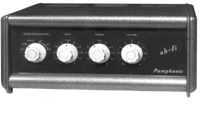 |
Pamphonic 1003 mono integrated amplifier |
|
Pamphonic Amplifier 1003. Pamphonic Reproducers
Ltd. Price 27 gns. This is a most interesting amplifier of the "Junior", 10-watt type. Both Control Unit and Main Amplifier are in one rugged metal case of quite handsome appearance, finished in mottled green. It needs no separate housing but can be put on a shelf or in a bookcase. It is thus of ideal shape, size and appearance for the flat-dweller or indeed for any location where space is limited or where a "contemporary" approach is called for. Although only 6 valves, including rectifier, are used, the circuit is actually of 5 stages with twin valve, phase inverter stage and push-pull output. Moreover, the various controls are effectively distributed so as to avoid undesirable interaction, and in this way a high degree of stability is assured. Thus only the input selector comes before the first valve (EF86); then between that valve and the first half of the ECC83 come the fixed equalisers for the different recording characteristics; between the two halves of the ECC83 come the bass and treble controls on the now famous Baxendall circuit; then come the volume control feeding the ECC83 in the phase inverter stage; and finally come the two 6AQ5's in the ultra linear push-pull output stage. The output for coupling to the input of a tape recorder is taken from the upper end of the volume control but after the coupling capacitor of that stage. The main feedback loop goes from the secondary of the output transformer to the first cathode of the phase inverter stage. The more I examine the circuit of this amplifier the more I become impressed with the skill - no, cunning, of its designer. He obviously set himself certain limited objectives as to output, frequency range, size and cost, and he has achieved those objectives with remarkably little distortion at high output and with no surrender of stability. I was particularly glad to see how he had avoided the risk of inadvertent positive feedback to the input stage causing the first valve to become unduly sensitive and therefore prone to self-oscillation. The carrying out of the design commands respect. The choice of components, output transformer included, has been quite generous and the layout and wiring are beyond reproach. I like the edge-illuminated Perspex panel which show up the graduations of the various controls even in the most adverse conditions of lighting. The performance, as one could only expect, is first class, and entirely adequate to get the best for modern records and FM transmissions in ordinary home listening conditions. The fact that there is no steep-cut treble filter perhaps makes it less suitable for some of the older recordings, but the value of such a control is often exaggerated: it is not an adequate answer to excessive surface noise, for example; that, I believe, lies in the pickup and the stylus. Some readers may wonder whether the record equalisation is the best compromise amongst the many possibilities. For example, I myself would have chosen to have American Columbia pre-standard in place of Decca LP, since the former was one of the extremes. Fortunately, however, it matters little since the Baxendall treble and bass circuit is versatile enough to make up for differences of that sort. |
|||
 Taken
from 'The Gramophone', December 1956
Taken
from 'The Gramophone', December 1956